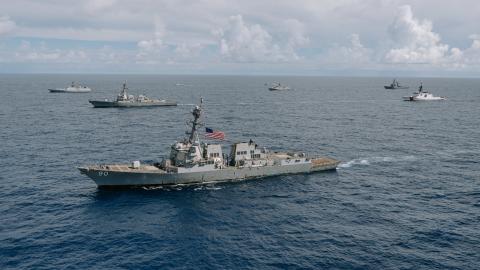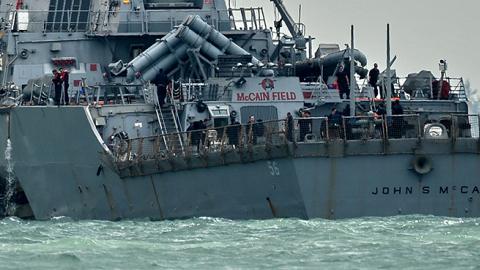Sunrise in Singapore on Aug. 21 came at 7:03. Nearly an hour and a half earlier, the guided-missile destroyer USS John S. McCain —named for Sen. John McCain’s father and grandfather, both admirals—collided with a Liberian-flagged tanker ship near the heavily traveled Strait of Malacca. Ten sailors died.
This was the fourth accident this year for the U.S. Seventh Fleet, headquartered in Yokosuka, Japan. In January a guided-missile cruiser, the USS Antietam, ran aground in a high tide and strong winds after dragging her anchor in Tokyo Bay. The Antietam’s commanding officer was subsequently relieved and reassigned to a post at fleet headquarters.
In May the USS Lake Champlain, another cruiser, collided with a South Korean fishing vessel east of the Korean Peninsula. The Navy crew had tried to signal the fishermen, who neither had a radio nor responded to the ship’s horn. No one was injured.
Then in June the USS Fitzgerald, a guided-missile destroyer, suffered significant damage in a collision with a Philippine-flagged container ship in the busy approaches to Tokyo Bay. Seven American sailors died. After an investigation, the ship’s commanding and executive officers were relieved.
Speculation that sabotage or hacking had anything to do with these accidents seems unfounded. Navy ships have personnel constantly at watch, both on and off the bridge, to spot nearby vessels and other potential dangers. Can Russia hack a sailor’s eyes?
On Aug. 21, Adm. John Richardson, the chief of naval operations, told ships world-wide to pause their activity for a one-day safety stand down. He also directed the Navy to investigate how it trains and certifies the forces that deploy to Japan. This inquiry will examine the pace of naval operations—whether ships are being overused—as well as maintenance, personnel and equipment.
A no-holds-barred analysis is needed, not least because American forces face rising danger on many fronts. China is moving aggressively in the South and East China Seas. North Korea threatens war in the Pacific and beyond. The Baltic and Black Seas are as hazardous as ever. Islamic State is being pushed back by an air war conducted in part from ships in the Eastern Mediterranean.
The Navy has its hands full simply answering requests from combatant commanders, the senior officers who lead U.S. forces around the world. The deployable battle force, at 276 ships, is far smaller than what’s needed to meet demand, and it isn’t growing. So the Navy has looked for other ways to answer the call. One has been to keep ships at sea longer. Although the gold standard for deployments once was six months, amphibious vessels recently have been sent out for close to twice that.
This helps the Navy maintain a constant presence, but at a price. Longer deployments put wear and tear on sailors, their families and the fleet. Equipment problems accumulate, but detailed maintenance must wait until ships return to port.
Adm. Richardson’s specific directive to examine Naval training is pivotal. In the Fitzgerald and McCain collisions, large merchant ships approached undetected until it was too late to avoid a mishap. The questions about seamanship are obvious, and they must be asked. Navy ships have radars, crew standing watch, officers responsible for safe navigation, and computers that calculate other vessels’ speed, direction and closest point of approach. The Navy needs to understand how the system failed twice in three months.
Is there any connection between long deployments and these fatal mistakes? Perhaps ships are being overused, leading to longer repairs once they return to port, which leaves inadequate time for training. A Government Accountability Office report last May noted this possibility: “The Navy has several options for mitigating extended maintenance availabilities and overruns, including the following: Condense training period (most common according to Navy officials) . . . ”
Has the Navy pushed practical training in seamanship and navigation too far into the realm of computers, forsaking harsher on-the-job learning? Does time spent preparing for inspections of ship systems come at the expense of training? Is the system for evaluating commanding officers functioning properly?
On Wednesday, the Seventh Fleet’s commander, Vice Adm. Joseph Aucoin, was relieved of his command—which in this case means that his career is over. This is appropriate and consistent with longstanding Navy practice. It does not, however, answer the question of whether there is sufficient accountability for officers who are relieved after sailors die in avoidable accidents.
Also lingering is the question Adm. Richardson did not ask: If the fleet is stretched to a breaking point, when does the Navy tell combatant commanders that it cannot safely supply all the ships they request?
The Navy has been diligent since the end of the Cold War in seeking ways to cut costs and increase effectiveness, as the fleet shrank and demands expanded. The two collisions this summer suggest that it has reached the limits of trying to manage its way out of the mismatch. If meeting combatant commanders’ requests for additional ships would push the fleet beyond workable limits, maybe the solution is to just say no.

















